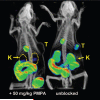Synthesis and evaluation of technetium-99m- and rhenium-labeled inhibitors of the prostate-specific membrane antigen (PSMA)
- PMID: 18637669
- PMCID: PMC3336105
- DOI: 10.1021/jm800111u
Synthesis and evaluation of technetium-99m- and rhenium-labeled inhibitors of the prostate-specific membrane antigen (PSMA)
Abstract
The prostate-specific membrane antigen (PSMA) is increasingly recognized as a viable target for imaging and therapy of cancer. We prepared seven (99m)Tc/Re-labeled compounds by attaching known Tc/Re chelating agents to an amino-functionalized PSMA inhibitor (lys-NHCONH-glu) with or without a variable length linker moiety. K i values ranged from 0.17 to 199 nM. Ex vivo biodistribution and in vivo imaging demonstrated the degree of specific binding to engineered PSMA+ PC3 PIP tumors. PC3-PIP cells are derived from PC3 that have been transduced with the gene for PSMA. Despite demonstrating nearly the lowest PSMA inhibitory potency of this series, [(99m)Tc(CO)3( L1)] (+) ( L1 = (2-pyridylmethyl)2N(CH2) 4CH(CO2H)NHCO-(CH2) 6CO-NH-lys-NHCONH-glu) showed the highest, most selective PIP tumor uptake, at 7.9 +/- 4.0% injected dose per gram of tissue at 30 min postinjection. Radioactivity cleared from nontarget tissues to produce a PIP to flu (PSMA-PC3) ratio of 44:1 at 120 min postinjection. PSMA can accommodate the steric requirements of (99m)Tc/Re complexes within PSMA inhibitors, the best results achieved with a linker moiety between the epsilon amine of the urea lysine and the chelator.
Figures













References
-
- Jemal A, Murray T, Samuels A, Ghafoor A, Ward E, Thun MJ. Cancer statistics, 2003. Ca Cancer J. Clin. 2003;53:5–26. - PubMed
-
- Lange PH. PROSTASCINT scan for staging prostate cancer. Urology. 2001;57:402–406. - PubMed
-
- Haseman MK, Rosenthal SA, Polascik TJ. Capromab pendetide imaging of prostate cancer. Cancer Biother. Radiopharm. 2000;15:131–140. - PubMed
-
- Rosenthal SA, Haseman MK, Polascik TJ. Utility of capromab pendetide (ProstaScint) imaging in the management of prostate cancer. Tech. Urol. 2001;7:27–37. - PubMed
-
- Scher B, Seitz M, Albinger W, Tiling R, Scherr M, Becker HC, Souvatzogluou M, Gildehaus FJ, Wester HJ, Dresel S. Value of 11C-choline PET and PET/CT in patients with suspected prostate cancer. Eur. J. Nucl. Med. Mol. Imaging. 2007;34:45–53. - PubMed
Publication types
MeSH terms
Substances
Grants and funding
LinkOut - more resources
Full Text Sources
Other Literature Sources
Miscellaneous

